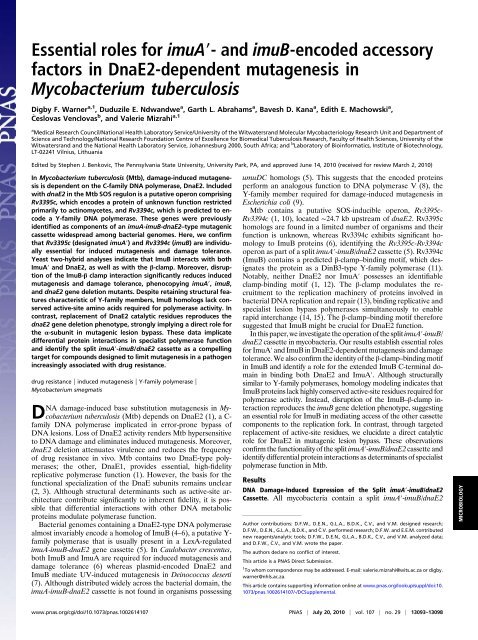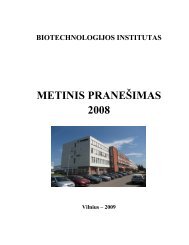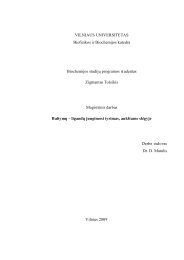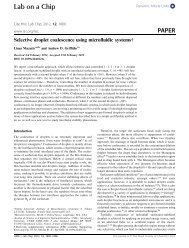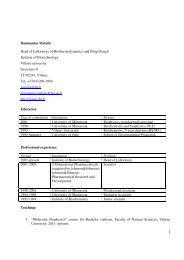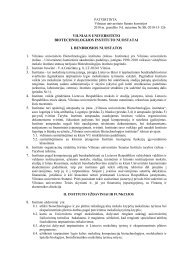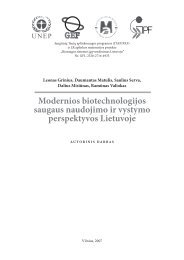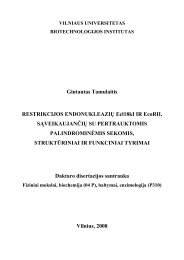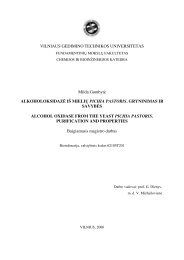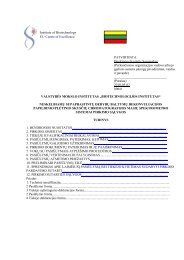Essential roles for imuA â²- and imuB-encoded accessory factors in ...
Essential roles for imuA â²- and imuB-encoded accessory factors in ...
Essential roles for imuA â²- and imuB-encoded accessory factors in ...
Create successful ePaper yourself
Turn your PDF publications into a flip-book with our unique Google optimized e-Paper software.
<strong>Essential</strong> <strong>roles</strong> <strong>for</strong> <strong>imuA</strong>′- <strong>and</strong><strong>imuB</strong>-<strong>encoded</strong> <strong>accessory</strong><br />
<strong>factors</strong> <strong>in</strong> DnaE2-dependent mutagenesis <strong>in</strong><br />
Mycobacterium tuberculosis<br />
Digby F. Warner a,1 , Duduzile E. Ndw<strong>and</strong>we a , Garth L. Abrahams a , Bavesh D. Kana a , Edith E. Machowski a ,<br />
Ceslovas Venclovas b , <strong>and</strong> Valerie Mizrahi a,1<br />
a Medical Research Council/National Health Laboratory Service/University of the Witwatersr<strong>and</strong> Molecular Mycobacteriology Research Unit <strong>and</strong> Department of<br />
Science <strong>and</strong> Technology/National Research Foundation Centre of Excellence <strong>for</strong> Biomedical Tuberculosis Research, Faculty of Health Sciences, University of the<br />
Witwatersr<strong>and</strong> <strong>and</strong> the National Health Laboratory Service, Johannesburg 2000, South Africa; <strong>and</strong> b Laboratory of Bio<strong>in</strong><strong>for</strong>matics, Institute of Biotechnology,<br />
LT-02241 Vilnius, Lithuania<br />
Edited by Stephen J. Benkovic, The Pennsylvania State University, University Park, PA, <strong>and</strong> approved June 14, 2010 (received <strong>for</strong> review March 2, 2010)<br />
In Mycobacterium tuberculosis (Mtb), damage-<strong>in</strong>duced mutagenesis<br />
is dependent on the C-family DNA polymerase, DnaE2. Included<br />
with dnaE2 <strong>in</strong> the Mtb SOS regulon is a putative operon compris<strong>in</strong>g<br />
Rv3395c, which encodes a prote<strong>in</strong> of unknown function restricted<br />
primarily to act<strong>in</strong>omycetes, <strong>and</strong> Rv3394c, which is predicted to encode<br />
a Y-family DNA polymerase. These genes were previously<br />
identified as components of an <strong>imuA</strong>-<strong>imuB</strong>-dnaE2–type mutagenic<br />
cassette widespread among bacterial genomes. Here, we confirm<br />
that Rv3395c (designated <strong>imuA</strong>′) <strong>and</strong> Rv3394c (<strong>imuB</strong>) are <strong>in</strong>dividually<br />
essential <strong>for</strong> <strong>in</strong>duced mutagenesis <strong>and</strong> damage tolerance.<br />
Yeast two-hybrid analyses <strong>in</strong>dicate that ImuB <strong>in</strong>teracts with both<br />
ImuA′ <strong>and</strong> DnaE2, as well as with the β-clamp. Moreover, disruption<br />
of the ImuB-β clamp <strong>in</strong>teraction significantly reduces <strong>in</strong>duced<br />
mutagenesis <strong>and</strong> damage tolerance, phenocopy<strong>in</strong>g <strong>imuA</strong>′, <strong>imuB</strong>,<br />
<strong>and</strong> dnaE2 gene deletion mutants. Despite reta<strong>in</strong><strong>in</strong>g structural features<br />
characteristic of Y-family members, ImuB homologs lack conserved<br />
active-site am<strong>in</strong>o acids required <strong>for</strong> polymerase activity. In<br />
contrast, replacement of DnaE2 catalytic residues reproduces the<br />
dnaE2 gene deletion phenotype, strongly imply<strong>in</strong>g a direct role <strong>for</strong><br />
the α-subunit <strong>in</strong> mutagenic lesion bypass. These data implicate<br />
differential prote<strong>in</strong> <strong>in</strong>teractions <strong>in</strong> specialist polymerase function<br />
<strong>and</strong> identify the split <strong>imuA</strong>′-<strong>imuB</strong>/dnaE2 cassette as a compell<strong>in</strong>g<br />
target <strong>for</strong> compounds designed to limit mutagenesis <strong>in</strong> a pathogen<br />
<strong>in</strong>creas<strong>in</strong>gly associated with drug resistance.<br />
drug resistance | <strong>in</strong>duced mutagenesis | Y-family polymerase |<br />
Mycobacterium smegmatis<br />
DNA damage-<strong>in</strong>duced base substitution mutagenesis <strong>in</strong> Mycobacterium<br />
tuberculosis (Mtb) depends on DnaE2 (1), a C-<br />
family DNA polymerase implicated <strong>in</strong> error-prone bypass of<br />
DNA lesions. Loss of DnaE2 activity renders Mtb hypersensitive<br />
to DNA damage <strong>and</strong> elim<strong>in</strong>ates <strong>in</strong>duced mutagenesis. Moreover,<br />
dnaE2 deletion attenuates virulence <strong>and</strong> reduces the frequency<br />
of drug resistance <strong>in</strong> vivo. Mtb conta<strong>in</strong>s two DnaE-type polymerases;<br />
the other, DnaE1, provides essential, high-fidelity<br />
replicative polymerase function (1). However, the basis <strong>for</strong> the<br />
functional specialization of the DnaE subunits rema<strong>in</strong>s unclear<br />
(2, 3). Although structural determ<strong>in</strong>ants such as active-site architecture<br />
contribute significantly to <strong>in</strong>herent fidelity, it is possible<br />
that differential <strong>in</strong>teractions with other DNA metabolic<br />
prote<strong>in</strong>s modulate polymerase function.<br />
Bacterial genomes conta<strong>in</strong><strong>in</strong>g a DnaE2-type DNA polymerase<br />
almost <strong>in</strong>variably encode a homolog of ImuB (4–6), a putative Y-<br />
family polymerase that is usually present <strong>in</strong> a LexA-regulated<br />
<strong>imuA</strong>-<strong>imuB</strong>-dnaE2 gene cassette (5). In Caulobacter crescentus,<br />
both ImuB <strong>and</strong> ImuA are required <strong>for</strong> <strong>in</strong>duced mutagenesis <strong>and</strong><br />
damage tolerance (6) whereas plasmid-<strong>encoded</strong> DnaE2 <strong>and</strong><br />
ImuB mediate UV-<strong>in</strong>duced mutagenesis <strong>in</strong> De<strong>in</strong>ococcus deserti<br />
(7). Although distributed widely across the bacterial doma<strong>in</strong>, the<br />
<strong>imuA</strong>-<strong>imuB</strong>-dnaE2 cassette is not found <strong>in</strong> organisms possess<strong>in</strong>g<br />
umuDC homologs (5). This suggests that the <strong>encoded</strong> prote<strong>in</strong>s<br />
per<strong>for</strong>m an analogous function to DNA polymerase V (8), the<br />
Y-family member required <strong>for</strong> damage-<strong>in</strong>duced mutagenesis <strong>in</strong><br />
Escherichia coli (9).<br />
Mtb conta<strong>in</strong>s a putative SOS-<strong>in</strong>ducible operon, Rv3395c-<br />
Rv3394c (1, 10), located ∼24.7 kb upstream of dnaE2. Rv3395c<br />
homologs are found <strong>in</strong> a limited number of organisms <strong>and</strong> their<br />
function is unknown, whereas Rv3394c exhibits significant homology<br />
to ImuB prote<strong>in</strong>s (6), identify<strong>in</strong>g the Rv3395c-Rv3394c<br />
operon as part of a split <strong>imuA</strong>′-<strong>imuB</strong>/dnaE2 cassette (5). Rv3394c<br />
(ImuB) conta<strong>in</strong>s a predicted β-clamp–b<strong>in</strong>d<strong>in</strong>g motif, which designates<br />
the prote<strong>in</strong> as a D<strong>in</strong>B3-type Y-family polymerase (11).<br />
Notably, neither DnaE2 nor ImuA′ possesses an identifiable<br />
clamp-b<strong>in</strong>d<strong>in</strong>g motif (1, 12). The β-clamp modulates the recruitment<br />
to the replication mach<strong>in</strong>ery of prote<strong>in</strong>s <strong>in</strong>volved <strong>in</strong><br />
bacterial DNA replication <strong>and</strong> repair (13), b<strong>in</strong>d<strong>in</strong>g replicative <strong>and</strong><br />
specialist lesion bypass polymerases simultaneously to enable<br />
rapid <strong>in</strong>terchange (14, 15). The β-clamp–b<strong>in</strong>d<strong>in</strong>g motif there<strong>for</strong>e<br />
suggested that ImuB might be crucial <strong>for</strong> DnaE2 function.<br />
In this paper, we <strong>in</strong>vestigate the operation of the split <strong>imuA</strong>′-<strong>imuB</strong>/<br />
dnaE2 cassette <strong>in</strong> mycobacteria. Our results establish essential <strong>roles</strong><br />
<strong>for</strong> ImuA′ <strong>and</strong> ImuB <strong>in</strong> DnaE2-dependent mutagenesis <strong>and</strong> damage<br />
tolerance. We also confirm the identity of the β-clamp–b<strong>in</strong>d<strong>in</strong>g motif<br />
<strong>in</strong> ImuB <strong>and</strong> identify a role <strong>for</strong> the extended ImuB C-term<strong>in</strong>al doma<strong>in</strong><br />
<strong>in</strong> b<strong>in</strong>d<strong>in</strong>g both DnaE2 <strong>and</strong> ImuA′. Although structurally<br />
similar to Y-family polymerases, homology model<strong>in</strong>g <strong>in</strong>dicates that<br />
ImuB prote<strong>in</strong>s lack highly conserved active-site residues required <strong>for</strong><br />
polymerase activity. Instead, disruption of the ImuB–β-clamp <strong>in</strong>teraction<br />
reproduces the <strong>imuB</strong> gene deletion phenotype, suggest<strong>in</strong>g<br />
an essential role <strong>for</strong> ImuB <strong>in</strong> mediat<strong>in</strong>g access of the other cassette<br />
components to the replication <strong>for</strong>k. In contrast, through targeted<br />
replacement of active-site residues, we elucidate a direct catalytic<br />
role <strong>for</strong> DnaE2 <strong>in</strong> mutagenic lesion bypass. These observations<br />
confirm the functionality of the split <strong>imuA</strong>′-<strong>imuB</strong>/dnaE2 cassette <strong>and</strong><br />
identify differential prote<strong>in</strong> <strong>in</strong>teractions as determ<strong>in</strong>ants of specialist<br />
polymerase function <strong>in</strong> Mtb.<br />
Results<br />
DNA Damage-Induced Expression of the Split <strong>imuA</strong>′-<strong>imuB</strong>/dnaE2<br />
Cassette. All mycobacteria conta<strong>in</strong> a split <strong>imuA</strong>′-<strong>imuB</strong>/dnaE2<br />
Author contributions: D.F.W., D.E.N., G.L.A., B.D.K., C.V., <strong>and</strong> V.M. designed research;<br />
D.F.W., D.E.N., G.L.A., B.D.K., <strong>and</strong> C.V. per<strong>for</strong>med research; D.F.W. <strong>and</strong> E.E.M. contributed<br />
new reagents/analytic tools; D.F.W., D.E.N., G.L.A., B.D.K., C.V., <strong>and</strong> V.M. analyzed data;<br />
<strong>and</strong> D.F.W., C.V., <strong>and</strong> V.M. wrote the paper.<br />
The authors declare no conflict of <strong>in</strong>terest.<br />
This article is a PNAS Direct Submission.<br />
1 To whom correspondence may be addressed. E-mail: valerie.mizrahi@wits.ac.za or digby.<br />
warner@nhls.ac.za.<br />
This article conta<strong>in</strong>s support<strong>in</strong>g <strong>in</strong><strong>for</strong>mation onl<strong>in</strong>e at www.pnas.org/lookup/suppl/doi:10.<br />
1073/pnas.1002614107/-/DCSupplemental.<br />
MICROBIOLOGY<br />
www.pnas.org/cgi/doi/10.1073/pnas.1002614107 PNAS | July 20, 2010 | vol. 107 | no. 29 | 13093–13098
cassette (5), except Mycobacterium leprae, which has lost these<br />
genes through genome decay (16). The genomic location varies<br />
across mycobacterial species: <strong>in</strong> Mycobacterium smegmatis mc 2 155<br />
(Msm), <strong>imuA</strong>′, <strong>and</strong><strong>imuB</strong> are situated only 10.8 kb upstream of<br />
dnaE2. However, the <strong>encoded</strong> prote<strong>in</strong>s are highly conserved, <strong>and</strong><br />
a LexA-b<strong>in</strong>d<strong>in</strong>g site is located <strong>in</strong> the promoter region upstream of<br />
<strong>imuA</strong>′ <strong>in</strong> Mtb (17) <strong>and</strong> Msm (Fig. S1B). Previous studies identified<br />
all three cassette components <strong>in</strong> the Mtb SOS regulon (1, 10), <strong>and</strong><br />
expression of dnaE2 was shown to parallel recA <strong>in</strong>duction (1). We<br />
analyzed transcript abundances of the cassette components relative<br />
to a sigA control (18) dur<strong>in</strong>g mid log-phase growth of Mtb <strong>and</strong><br />
follow<strong>in</strong>g UV exposure (Table S1) <strong>and</strong> compared with the non<strong>in</strong>ducible<br />
Y-family polymerases, d<strong>in</strong>B1 <strong>and</strong> d<strong>in</strong>B2 (10). All cassette<br />
genes were significantly up-regulated with<strong>in</strong> 6 h of UV treatment<br />
<strong>and</strong> rema<strong>in</strong>ed elevated at 24 h. dnaE1, which encodes the essential<br />
replicative α-subunit (1), was also up-regulated follow<strong>in</strong>g UV irradiation.<br />
Although there is no identifiable SOS box (17), a promoter<br />
motif regulat<strong>in</strong>g the LexA-<strong>in</strong>dependent damage response<br />
(10) is situated immediately upstream of dnaE1 (19), consistent<br />
with damage <strong>in</strong>duction.<br />
ImuA′ <strong>and</strong> ImuB Are Individually <strong>Essential</strong> <strong>for</strong> DnaE2 Function <strong>in</strong><br />
Mycobacteria. To <strong>in</strong>vestigate the <strong>roles</strong> of <strong>imuA</strong>′ <strong>and</strong> <strong>imuB</strong> <strong>in</strong><br />
DNA damage-<strong>in</strong>duced mutagenesis, allelic exchange mutants of<br />
Mtb H37Rv were constructed <strong>in</strong> which <strong>imuB</strong> alone, or both <strong>imuA</strong>′<br />
<strong>and</strong> <strong>imuB</strong>, were deleted <strong>and</strong> replaced by an antibiotic resistance<br />
marker (Fig. S1A). Neither mutant exhibited a phenotype under<br />
st<strong>and</strong>ard <strong>in</strong> vitro growth conditions. However, UV-<strong>in</strong>duced mutagenesis<br />
was elim<strong>in</strong>ated <strong>in</strong> both stra<strong>in</strong>s (Fig. 1A) as determ<strong>in</strong>ed by<br />
mutation frequencies to rifampic<strong>in</strong> resistance (Rif R ). The damage<strong>in</strong>duced<br />
mutator phenotype was restored by complementation<br />
with a fragment carry<strong>in</strong>g both <strong>imuA</strong>′ <strong>and</strong> <strong>imuB</strong> genes <strong>in</strong>tegrated at<br />
the attB site. Moreover, loss of <strong>imuA</strong>′-<strong>imuB</strong> reproduced the dnaE2<br />
deletion phenotype (1), confirm<strong>in</strong>g the functionality of the split<br />
<strong>imuA</strong>′-<strong>imuB</strong>/dnaE2 cassette. To determ<strong>in</strong>e the <strong>in</strong>dividual requirements<br />
<strong>for</strong> <strong>imuA</strong>′ <strong>and</strong> <strong>imuB</strong>, the similar genomic arrangement <strong>in</strong><br />
Msm was exploited (Fig. S1B). Deletion of <strong>imuB</strong> significantly reduced<br />
the UV-<strong>in</strong>duced Rif R frequency <strong>in</strong> Msm (Fig. 1B), mimick<strong>in</strong>g<br />
<strong>in</strong>activation of dnaE2 (1). The same phenotype resulted<br />
from deletion of <strong>imuA</strong>′ <strong>and</strong> was complemented by <strong>in</strong>tegration of<br />
a wild-type copy of <strong>imuA</strong>′. These data established the <strong>in</strong>dividual<br />
essentiality of ImuA′ <strong>and</strong> ImuB <strong>for</strong> <strong>in</strong>duced mutagenesis <strong>and</strong><br />
confirmed the designation of the mycobacterial ImuA′ as a distant<br />
homolog of ImuA (5, 6). Msm <strong>imuA</strong>′ <strong>and</strong> <strong>imuB</strong> deletion mutants<br />
were hypersensitive to mitomyc<strong>in</strong> C (MMC), a genotoxic agent<br />
known to <strong>in</strong>duce the SOS response <strong>in</strong> mycobacteria (1) (Fig. S1C).<br />
Deletion of all three components (ΔdnaE2 Δ<strong>imuA</strong>′ Δ<strong>imuB</strong>) did not<br />
<strong>in</strong>crease damage sensitivity relative to <strong>in</strong>dividual deletion mutants<br />
(Δ<strong>imuA</strong>′, Δ<strong>imuB</strong>,orΔdnaE2)(Fig. S1C). Moreover, <strong>in</strong>tegration of<br />
wild-type copies of the deleted genes at the attB (<strong>imuA</strong>′-<strong>imuB</strong>)<strong>and</strong><br />
attL (dnaE2) sites reversed the MMC-hypersensitive phenotype of<br />
the ΔdnaE2 Δ<strong>imuA</strong>′ Δ<strong>imuB</strong> triple mutant, confirm<strong>in</strong>g that all three<br />
genes operate <strong>in</strong> a s<strong>in</strong>gle pathway.<br />
ImuB Lacks Active Site Residues Required <strong>for</strong> DNA Polymerase Activity.<br />
ImuB occupies a dist<strong>in</strong>ct branch of the UmuC subfamily of Y-<br />
family polymerases (6) <strong>and</strong> possesses all structural doma<strong>in</strong>s typical<br />
of Y-family members, <strong>in</strong>clud<strong>in</strong>g the def<strong>in</strong><strong>in</strong>g little f<strong>in</strong>ger (20) (Fig.<br />
2A). A putative β-clamp–b<strong>in</strong>d<strong>in</strong>g motif ( 354 QLPLWG 359 )thatis<br />
located between the Y polymerase-like N-term<strong>in</strong>al region <strong>and</strong> the<br />
C-term<strong>in</strong>al extension characteristic of ImuB prote<strong>in</strong>s identified<br />
Mtb ImuB as founder of the D<strong>in</strong>B3-type Y-family polymerases<br />
(11) (Fig. S2). Although classified as a Y-family member, comparative<br />
sequence analyses <strong>and</strong> homology model<strong>in</strong>g <strong>in</strong>dicate that<br />
the expected carboxylates (21) are replaced by other residues <strong>in</strong> the<br />
ImuB active site (Fig. 2B). The absence of the complete triad of<br />
active-site acidic residues is a feature of all ImuB homologs analyzed<br />
(Fig. S2) <strong>and</strong> strongly implies that these prote<strong>in</strong>s cannot<br />
function as DNA polymerases (22). In turn, this observation suggests<br />
a model <strong>for</strong> translesion synthesis <strong>in</strong> which DnaE2 itself catalyzes<br />
lesion bypass (6).<br />
Catalytic Activity of DnaE2 Is Required <strong>for</strong> Induced Mutagenesis <strong>in</strong><br />
Mtb. All three DNA polymerase IIIα active-site acidic residues<br />
(23, 24) are present <strong>in</strong> Mtb DnaE2 (D 439 ,D 441 ,D 579 ; Fig. S3). To<br />
determ<strong>in</strong>e the requirement <strong>for</strong> DnaE2 polymerase activity <strong>in</strong><br />
damage tolerance <strong>and</strong> <strong>in</strong>duced mutagenesis <strong>in</strong> mycobacteria,<br />
a site-directed Msm mutant was generated <strong>in</strong> which catalytic<br />
function was crippled by replacement of two correspond<strong>in</strong>g active-site<br />
aspartates with alan<strong>in</strong>es ( 441 DID 443 → 441 AIA 443 ). The<br />
chromosomal dnaE2 AIA mutation elim<strong>in</strong>ated UV-<strong>in</strong>duced mutagenesis<br />
(Fig. 3A) <strong>and</strong> rendered Msm hypersensitive to MMC<br />
(Fig. 3B). The fact that the dnaE2 AIA mutation phenocopied the<br />
ΔdnaE2 knockout strongly implied a direct role <strong>for</strong> DnaE2 <strong>in</strong><br />
catalyz<strong>in</strong>g translesion synthesis.<br />
QLPLWG Clamp-B<strong>in</strong>d<strong>in</strong>g Motif Mediates the Interaction of ImuB with<br />
β. A β-clamp–b<strong>in</strong>d<strong>in</strong>g motif ( 946 QFDLF 950 ) (12) is situated <strong>in</strong> the<br />
β-b<strong>in</strong>d<strong>in</strong>g doma<strong>in</strong> of Mtb DnaE1 (Fig. S3). The correspond<strong>in</strong>g<br />
region <strong>in</strong> Mtb DnaE2 ( 924 RPDRLPGVG 932 ) is <strong>in</strong>variant <strong>in</strong> mycobacterial<br />
genomes, but does not resemble known β-b<strong>in</strong>d<strong>in</strong>g<br />
motifs (11, 12). We showed recently (25) that the dnaN-<strong>encoded</strong><br />
β-subunit <strong>in</strong>teracts with DnaE1 <strong>and</strong> with itself <strong>in</strong> yeast two-hybrid<br />
(Y2H) assays, but does not b<strong>in</strong>d DnaE2 (Fig. 4). Similarly,<br />
Mtb ImuA′ failed to b<strong>in</strong>d β, whereas an <strong>in</strong>teraction between<br />
ImuB <strong>and</strong> the β-clamp was readily detected. In comb<strong>in</strong>ation,<br />
these data establish ImuB as the only cassette component with<br />
β-b<strong>in</strong>d<strong>in</strong>g capacity <strong>in</strong> Mtb. The observed <strong>in</strong>teraction was consistent<br />
with the β-b<strong>in</strong>d<strong>in</strong>g motif ( 354 QLPLWG 359 ) <strong>in</strong> ImuB that<br />
characterizes the D<strong>in</strong>B3 family (11) <strong>and</strong> is highly conserved<br />
among mycobacterial ImuBs. Moreover, a Q354A mutation<br />
(ImuB ALPLWG ) elim<strong>in</strong>ated the ImuB–β <strong>in</strong>teraction <strong>in</strong> the Y2H<br />
system (Fig. 4), confirm<strong>in</strong>g a role <strong>for</strong> this motif <strong>in</strong> clamp b<strong>in</strong>d<strong>in</strong>g.<br />
Fig. 1. ImuA′ <strong>and</strong> ImuB are essential <strong>for</strong> <strong>in</strong>duced mutagenesis. UV-<strong>in</strong>duced mutation frequencies to rifampic<strong>in</strong> resistance (Rif R )<strong>in</strong>(A) Mtb at 24 <strong>and</strong> 48 h <strong>and</strong><br />
(B) Msm at 4.5 h post UV treatment. Data represent s<strong>in</strong>gle experiments per<strong>for</strong>med <strong>in</strong> triplicate.<br />
13094 | www.pnas.org/cgi/doi/10.1073/pnas.1002614107 Warner et al.
Fig. 2. ImuB is a homolog of Y-family polymerases but lacks active-site acidic<br />
residues. (A) Comparison of the Mtb ImuB homology model with the X-ray<br />
structure of Sulfolobus solfataricus Dpo4 complexed with DNA <strong>and</strong> <strong>in</strong>com<strong>in</strong>g<br />
nucleotide (PDB id: 1jx4) (21). ImuB is colored from N term<strong>in</strong>us (blue) to C term<strong>in</strong>us<br />
(red). (Center) The superimposed structures. (B) Close-up of the active site<br />
of Dpo4 <strong>and</strong> correspond<strong>in</strong>g residues <strong>in</strong> ImuB. Only the palm doma<strong>in</strong> is shown <strong>in</strong><br />
both structures. The <strong>in</strong>com<strong>in</strong>g nucleotide <strong>in</strong> the Dpo4–DNA complex is colored<br />
p<strong>in</strong>k, <strong>and</strong> the magnesium ion is shown as a cyan sphere.<br />
Prote<strong>in</strong> Interactions of the Split <strong>imuA</strong>′-<strong>imuB</strong>/dnaE2 Cassette Components<br />
<strong>in</strong> Mtb. Y2H analyses identified an ImuA′–ImuB <strong>in</strong>teraction that was<br />
reta<strong>in</strong>ed <strong>in</strong> the ImuB ALPLWG mutant (Fig. 4), confirm<strong>in</strong>g the specificity<br />
of the 354 QLPLWG 359 motif <strong>for</strong> b<strong>in</strong>d<strong>in</strong>g β. In addition, both<br />
ImuB <strong>and</strong> ImuB ALPLWG <strong>in</strong>teracted with DnaE2, whereas DnaE2<br />
<strong>and</strong> ImuA′ failed to <strong>in</strong>teract with any prote<strong>in</strong> analyzed other than<br />
ImuB. The active-site mutant <strong>for</strong>m of DnaE2, DnaE2 AIA , reta<strong>in</strong>ed<br />
the ability to b<strong>in</strong>d ImuB (Fig. 4), confirm<strong>in</strong>g that loss of DnaE2<br />
catalytic activity—<strong>and</strong>notdisruptionofthe<strong>in</strong>ferredImuB–DnaE2<br />
<strong>in</strong>teraction—was responsible <strong>for</strong> the phenotypes of the Msm<br />
dnaE2 AIA mutant stra<strong>in</strong> (Fig. 3). Interactions of ImuB with DnaE1<br />
<strong>and</strong> with itself were also elucidated (Fig. 4), identify<strong>in</strong>g multiple<br />
partners <strong>for</strong> ImuB (Fig. S4A).<br />
C-Term<strong>in</strong>al Region of ImuB Is Required <strong>for</strong> Interaction with Other<br />
Cassette Components. We could not detect a relationship between<br />
the C-term<strong>in</strong>al region of Mtb ImuB <strong>and</strong> any known prote<strong>in</strong><br />
structure. However, this region conta<strong>in</strong>s stretches of predicted<br />
structural disorder (Fig. S4B) thatareahallmarkofprote<strong>in</strong>–<br />
prote<strong>in</strong> <strong>in</strong>teraction sites (26). We generated Y2H constructs <strong>in</strong><br />
which nonsense codons were <strong>in</strong>troduced <strong>in</strong>to ImuB to preserve<br />
N-term<strong>in</strong>al Y-family structural doma<strong>in</strong>s while progressively<br />
elim<strong>in</strong>at<strong>in</strong>g C-term<strong>in</strong>al segments (Fig. 4). In Mtb ImuB C168 ,the<br />
entire 168-am<strong>in</strong>o-acid C-term<strong>in</strong>al region is elim<strong>in</strong>ated downstream<br />
of the <strong>in</strong>tact 354 QLPLWG 359 motif. The truncated ImuB<br />
reta<strong>in</strong>ed its <strong>in</strong>teraction with β,confirm<strong>in</strong>g the identity of the clampb<strong>in</strong>d<strong>in</strong>g<br />
motif. In contrast, the ability to b<strong>in</strong>d β was elim<strong>in</strong>ated <strong>in</strong><br />
ImuB CB <strong>in</strong> which both the C-term<strong>in</strong>al region <strong>and</strong> the 354 QLPLWG 359<br />
motif were deleted (Fig. 4). Both truncation mutants, ImuB C168 <strong>and</strong><br />
ImuB CB , lost the ability to b<strong>in</strong>d DnaE1, DnaE2, <strong>and</strong> ImuA′,<br />
confirm<strong>in</strong>g the <strong>in</strong>volvement of the C-term<strong>in</strong>al region of ImuB <strong>in</strong><br />
multiple prote<strong>in</strong> <strong>in</strong>teractions. To evaluate the requirement <strong>for</strong><br />
the C-term<strong>in</strong>al–dependent ImuB <strong>in</strong>teractions <strong>in</strong> cassette function,<br />
we constructed <strong>in</strong>tegrat<strong>in</strong>g vectors carry<strong>in</strong>g wild-type Msm <strong>imuA</strong>′<br />
<strong>and</strong> mutant <strong>imuB</strong> alleles with equivalent C-term<strong>in</strong>al truncations<br />
(<strong>imuA</strong>′-<strong>imuB</strong> C168 <strong>and</strong> <strong>imuA</strong>′-<strong>imuB</strong> CB ). Both constructs restored<br />
full function to the Msm Δ<strong>imuA</strong>′ mutant, but failed to complement<br />
the <strong>in</strong>duced mutagenesis (Fig. S5A) <strong>and</strong> damage tolerance (Fig.<br />
S5B) phenotypes of the s<strong>in</strong>gle Δ<strong>imuB</strong> <strong>and</strong> double Δ<strong>imuA</strong>′ Δ<strong>imuB</strong><br />
knockout stra<strong>in</strong>s, thereby support<strong>in</strong>g a critical role <strong>for</strong> ImuB–<br />
DnaE2 <strong>and</strong>/or ImuB–ImuA′ <strong>in</strong>teraction(s) <strong>in</strong> pathway function.<br />
By mapp<strong>in</strong>g the ImuA′ sequence onto the RecA structure (Fig.<br />
5A), we also designed N- <strong>and</strong> C-term<strong>in</strong>al truncations of ImuA′ <strong>and</strong><br />
assessed their effects on the <strong>in</strong>teraction with ImuB (Fig. 4). Removal<br />
of 31 (ImuA′ N31 ) or 48 (ImuA′ N48 ) am<strong>in</strong>o acids from the N<br />
term<strong>in</strong>us (elim<strong>in</strong>at<strong>in</strong>g the predicted N-term<strong>in</strong>al subdoma<strong>in</strong>; Fig.<br />
5A <strong>and</strong> Fig. S6) had no impact on the ability of ImuA′ to b<strong>in</strong>d ImuB<br />
<strong>in</strong> Y2H assays (Fig. 4). In contrast, a 44-am<strong>in</strong>o-acid C-term<strong>in</strong>al<br />
truncation (ImuA′ C ) elim<strong>in</strong>ated ImuB b<strong>in</strong>d<strong>in</strong>g. The correspond<strong>in</strong>g<br />
truncation <strong>in</strong> Msm <strong>imuA</strong>′ abrogated the ability of a complement<strong>in</strong>g<br />
vector to restore damage tolerance to the Δ<strong>imuA</strong>′<br />
deletion mutant (Fig. 5B). However, as the C-term<strong>in</strong>al truncation<br />
might have affected the structural <strong>in</strong>tegrity of the prote<strong>in</strong>, it is<br />
uncerta<strong>in</strong> whether this region alone or the entire structural doma<strong>in</strong><br />
is required <strong>for</strong> the ImuA′–ImuB <strong>in</strong>teraction.<br />
ImuB–β-Clamp Interaction Is Required <strong>for</strong> Induced Mutagenesis. A<br />
survey of representative <strong>imuB</strong>/dnaE2-conta<strong>in</strong><strong>in</strong>g bacteria revealed<br />
clamp-b<strong>in</strong>d<strong>in</strong>g motifs <strong>in</strong> ImuB <strong>and</strong> DnaE2 prote<strong>in</strong>s (Figs. S2 <strong>and</strong><br />
S3), suggest<strong>in</strong>g that at least one of these components must b<strong>in</strong>d β <strong>for</strong><br />
cassette function. To test this hypothesis, we constructed an <strong>in</strong>tegration<br />
vector carry<strong>in</strong>g wild-type <strong>imuA</strong> <strong>and</strong> <strong>imuB</strong> ALPLWG ,which<br />
encodes ImuB with a mutated β-b<strong>in</strong>d<strong>in</strong>g motif ( 352 ALPLWG 357 ),<br />
<strong>and</strong> evaluated its ability to complement the Msm Δ<strong>imuA</strong>′ Δ<strong>imuB</strong><br />
double mutant. The equivalent mutation had disrupted the ImuB–β<br />
<strong>in</strong>teraction <strong>in</strong> Y2H assays (Fig. 4). However, a s<strong>in</strong>gle Q352A substitution<br />
had no impact on the ability of the complement<strong>in</strong>g vector to<br />
restore damage tolerance <strong>and</strong> <strong>in</strong>duced mutagenesis to wild-type<br />
levels <strong>in</strong> Msm (Fig. S7), probably reflect<strong>in</strong>g the <strong>in</strong>ability of the yeast<br />
system to reproduce all elements contribut<strong>in</strong>g to prote<strong>in</strong>–prote<strong>in</strong><br />
<strong>in</strong>teractions <strong>in</strong> the natural mycobacterial host. There<strong>for</strong>e, we constructed<br />
additional alleles conta<strong>in</strong><strong>in</strong>g multiple mutations that targeted<br />
hydrophobic <strong>and</strong>/or aromatic residues <strong>in</strong> the putative ImuB<br />
β-b<strong>in</strong>d<strong>in</strong>g motif. Two alleles conta<strong>in</strong><strong>in</strong>g double mutations, imu-<br />
B AAPLWG <strong>and</strong> <strong>imuB</strong> ALPLGG , reta<strong>in</strong>ed ImuB function (Fig. 6).<br />
However, mutation of the first five β-b<strong>in</strong>d<strong>in</strong>g motif residues <strong>in</strong><br />
<strong>imuB</strong> AAAAGG elim<strong>in</strong>ated the ability of the result<strong>in</strong>g vector to complement<br />
the <strong>in</strong>duced mutagenesis (Fig. 6A) <strong>and</strong> damage tolerance<br />
(Fig. 6B)phenotypesofΔ<strong>imuA</strong>′ Δ<strong>imuB</strong>, strongly suggest<strong>in</strong>g that the<br />
ImuB–β-clamp <strong>in</strong>teraction is required <strong>for</strong> cassette operation.<br />
MICROBIOLOGY<br />
Fig. 3. DnaE2 catalytic activity is required <strong>for</strong> <strong>in</strong>duced<br />
mutagenesis <strong>and</strong> damage tolerance. (A) UV-<strong>in</strong>duced<br />
mutation frequencies to rifampic<strong>in</strong> resistance (Rif R ). (B)<br />
Sensitivity to MMC treatment. Log-fold dilutions were<br />
plated on antibiotic-free medium or on medium conta<strong>in</strong><strong>in</strong>g<br />
MMC at 0.02 <strong>and</strong> 0.04 μg·ml −1 . Data are from<br />
a representative experiment per<strong>for</strong>med <strong>in</strong> triplicate.<br />
Warner et al. PNAS | July 20, 2010 | vol. 107 | no. 29 | 13095
Fig. 4. Interactions of cassette components. Summary of Mtb prote<strong>in</strong> <strong>in</strong>teractions detected (●) or absent (×) on highest str<strong>in</strong>gency growth medium as<br />
identified <strong>in</strong> this study <strong>and</strong> previously (25). ND, not determ<strong>in</strong>ed. An open circle (o) <strong>in</strong>dicates <strong>in</strong>teractions ma<strong>in</strong>ta<strong>in</strong>ed where bait or prey vector conta<strong>in</strong>s fulllength<br />
ImuB; ImuB self-association is elim<strong>in</strong>ated when both vectors carry the ImuB C168 allele. A blue bar <strong>in</strong>dicates the position of the β-clamp–b<strong>in</strong>d<strong>in</strong>g motif<br />
( 354 QLPLWG 359 ) deleted <strong>in</strong> ImuB CB <strong>and</strong> mutated (XXX) <strong>in</strong> ImuB ALPLWG . The 439 AIA 441 mutation <strong>in</strong> Mtb DnaE2 is <strong>in</strong>dicated (XXX). L<strong>in</strong>es are to scale.<br />
Discussion<br />
The phenotypes associated with knockout of Mtb dnaE2 suggested<br />
a functional analogy with E. coli DNA polymerase V (1).<br />
Here, we extended those observations, demonstrat<strong>in</strong>g the essentiality<br />
of ImuA′ <strong>and</strong> ImuB <strong>for</strong> damage tolerance <strong>and</strong> <strong>in</strong>duced<br />
mutagenesis <strong>and</strong> establish<strong>in</strong>g that these prote<strong>in</strong>s act <strong>in</strong> the same<br />
pathway as DnaE2. We also confirmed the <strong>in</strong>ducible expression<br />
of dnaE2, <strong>imuA</strong>′, <strong>and</strong> <strong>imuB</strong> <strong>and</strong> identified dnaE1 as a component<br />
of the Mtb damage response. Previous studies <strong>in</strong>cluded DnaE2<br />
<strong>and</strong> ImuB among three damage-responsive DNA polymerases<br />
<strong>in</strong> Mtb (1, 10), the other be<strong>in</strong>g a putative DNA polymerase X<br />
(Rv3856c). However, the absence of active-site carboxylates<br />
appears <strong>in</strong>compatible with catalytic function <strong>in</strong> ImuB, whereas<br />
a truncated polymerase doma<strong>in</strong> probably precludes polymerase<br />
function <strong>in</strong> Rv3856c (Fig. S8). There<strong>for</strong>e, <strong>in</strong> contrast to E. coli<br />
DNA polymerase V, which is part of an SOS regulon that<br />
<strong>in</strong>cludes the additional specialist DNA polymerases II (B family)<br />
<strong>and</strong> IV (Y family) (reviewed <strong>in</strong> ref. 27), the polymerases <strong>in</strong>duced<br />
as part of the Mtb damage response seem to be limited to two<br />
α-subunits, DnaE1 <strong>and</strong> DnaE2.<br />
Po<strong>in</strong>t mutations <strong>in</strong> the DnaE2 active site elim<strong>in</strong>ated <strong>in</strong>duced<br />
mutagenesis <strong>and</strong> damage tolerance, reproduc<strong>in</strong>g the dnaE2 deletion<br />
phenotype. In comb<strong>in</strong>ation with the prediction that ImuB<br />
lacks polymerase activity, this observation implies that DnaE2<br />
catalyzes translesion synthesis. Unlike Y-family polymerases whose<br />
structures are adapted to specialist lesion bypass (20), sequence<br />
analysis reveals few clues to DnaE2 function. All major DNA<br />
polymerase IIIα structural/functional doma<strong>in</strong>s (23, 24) are readily<br />
identified <strong>in</strong> DnaE2, except <strong>for</strong> the very C-term<strong>in</strong>al region which <strong>in</strong><br />
E. coli has been implicated <strong>in</strong> the <strong>in</strong>teraction of α with the clamploader<br />
subunit, τ (28, 29). A strong α–τ <strong>in</strong>teraction enables simultaneous<br />
lead<strong>in</strong>g <strong>and</strong> lagg<strong>in</strong>g-str<strong>and</strong> synthesis by the DNA polymerase<br />
III holoenzyme (13), <strong>and</strong> the absence of this region <strong>in</strong><br />
DnaE2 <strong>and</strong> all other nonessential dnaE-type α-subunits (Fig. S3)<br />
might correlate with an <strong>in</strong>ability to substitute essential replicative<br />
function. Evidence implicat<strong>in</strong>g a defective α–τ <strong>in</strong>teraction <strong>in</strong> an<br />
E. coli mutator phenotype (30) further re<strong>in</strong><strong>for</strong>ces the potential<br />
contribution of τ-b<strong>in</strong>d<strong>in</strong>g to the functional specialization of DnaE<br />
subunits.<br />
Mtb DnaE2 does not b<strong>in</strong>d β. However, a highly conserved motif<br />
is located immediately downstream of the predicted OB fold doma<strong>in</strong><br />
<strong>in</strong> DnaE2 prote<strong>in</strong>s (Fig. S3), which suggests the potential <strong>for</strong><br />
other <strong>in</strong>termolecular <strong>in</strong>teractions. In E. coli, replicative polymerase<br />
fidelity is enhanced by the association of the α-subunit with<br />
the dnaQ-<strong>encoded</strong> proofread<strong>in</strong>g exonuclease, <strong>and</strong> disruptions to<br />
proofread<strong>in</strong>g activity enable DNA polymerase III-mediated lesion<br />
bypass <strong>in</strong> the absence of DNA polymerases IV <strong>and</strong> V (31, 32). In<br />
comb<strong>in</strong>ation, these observations suggest that differential <strong>in</strong>teractions<br />
with DnaQ-like prote<strong>in</strong>s might determ<strong>in</strong>e DnaE subunit<br />
function <strong>in</strong> Mtb. Additional 3′-5′ exonuclease activity was recently<br />
located to the PHP doma<strong>in</strong> of DnaE-type polymerases (33), although<br />
the contribution of this function to polymerase fidelity<br />
rema<strong>in</strong>s to be determ<strong>in</strong>ed. The correspond<strong>in</strong>g doma<strong>in</strong> of Mtb<br />
DnaE1 reta<strong>in</strong>s all am<strong>in</strong>o acids associated with exonuclease activity<br />
(34–36), whereas key residues are absent <strong>in</strong> DnaE2. Notably, the<br />
residues present <strong>in</strong> Mtb DnaE1 are conserved <strong>in</strong> the sole DnaE<br />
polymerase <strong>in</strong> M. leprae (Fig. S3), an organism marked by a complete<br />
lack of DnaQ homologs (37). There<strong>for</strong>e, although the<br />
functional consequence of these differences rema<strong>in</strong>s to be elucidated,<br />
it is tempt<strong>in</strong>g to speculate that loss of conserved residues <strong>in</strong><br />
the DnaE2 PHP doma<strong>in</strong> impacts relative fidelity.<br />
Our evidence <strong>in</strong>dicates a central role <strong>for</strong> ImuB <strong>in</strong> cassette<br />
function that is <strong>in</strong>dependent of polymerase activity. Structurally,<br />
ImuB resembles Y-family polymerases; however, the active-site<br />
architecture is <strong>in</strong>consistent with catalysis <strong>and</strong> <strong>in</strong>stead re<strong>in</strong><strong>for</strong>ces<br />
the likely importance of prote<strong>in</strong> <strong>in</strong>teractions <strong>for</strong> ImuB function.<br />
Consistent with this idea, we identified multiple partners <strong>for</strong><br />
ImuB, <strong>in</strong>clud<strong>in</strong>g DnaE1 <strong>and</strong> DnaE2, as well as ImuA′ <strong>and</strong> the<br />
β-clamp. We also established the capacity of ImuB to <strong>in</strong>teract<br />
with itself <strong>and</strong> implicated the C-term<strong>in</strong>al extension <strong>in</strong> this selfassociation<br />
<strong>and</strong> <strong>in</strong> the <strong>in</strong>teraction of ImuB with DnaE1, DnaE2,<br />
<strong>and</strong> ImuA′. The fact that the C term<strong>in</strong>us b<strong>in</strong>ds multiple partners<br />
suggests that this region mediates prote<strong>in</strong> <strong>in</strong>teractions that dist<strong>in</strong>guish<br />
ImuB from other Y-family members. Our Y2H experiments<br />
also confirmed the role of the D<strong>in</strong>B3-type QLPLWG motif <strong>in</strong> the<br />
<strong>in</strong>teraction of ImuB with β. Notably, disruption of this motif <strong>in</strong> the<br />
Fig. 5. ImuA′ is required <strong>for</strong> damage tolerance. (A) Comparison of the Mtb ImuA′ homology model <strong>and</strong> the X-ray structure of E. coli RecA (PDB id: 1u94) (57).<br />
ImuA′ is colored accord<strong>in</strong>g to truncation variants: blue <strong>and</strong> cyan <strong>in</strong>dicate N-term<strong>in</strong>al truncations, <strong>and</strong> red is the C-term<strong>in</strong>al truncation. (B) Deletion of 44 C-<br />
term<strong>in</strong>al am<strong>in</strong>o acids (<strong>imuA</strong>′ C ) renders Msm sensitive to MMC treatment. Log-fold dilutions were plated on antibiotic-free medium (Left <strong>and</strong> Right, Rows 1<br />
<strong>and</strong> 4), 0.02 μg·ml −1 (Left <strong>and</strong> Right, Rows 2 <strong>and</strong> 5), <strong>and</strong> 0.04 μg·mL −1 (Left <strong>and</strong> Right, Rows 3 <strong>and</strong> 6) MMC. Data are from a representative experiment<br />
per<strong>for</strong>med <strong>in</strong> duplicate.<br />
13096 | www.pnas.org/cgi/doi/10.1073/pnas.1002614107 Warner et al.
Fig. 6. The ImuB–β-clamp <strong>in</strong>teraction is required <strong>for</strong> <strong>in</strong>duced<br />
mutagenesis <strong>and</strong> damage tolerance. (A) UV-<strong>in</strong>duced<br />
mutation frequencies to rifampic<strong>in</strong> resistance (Rif R ). (B)<br />
Sensitivity to MMC treatment. Log-fold dilutions of Msm<br />
Δ<strong>imuA</strong>′ Δ<strong>imuB</strong> complemented with full-length <strong>imuA</strong>′-<strong>imuB</strong><br />
conta<strong>in</strong><strong>in</strong>g wild-type (WT) <strong>and</strong> mutant <strong>imuB</strong> alleles were<br />
plated on 0.02 μg·mL −1 (Rows 1, 3, 5, 7, <strong>and</strong>9) <strong>and</strong>0.04<br />
μg·ml −1 (Rows 2, 4, 6, 8, <strong>and</strong> 10) MMC; at right is the untreated<br />
control. Data are from a representative experiment<br />
per<strong>for</strong>med <strong>in</strong> duplicate.<br />
<strong>imuB</strong> AAAAGG allele elim<strong>in</strong>ated cassette function, strongly imply<strong>in</strong>g<br />
that ImuB—through β—is required to mediate access of DnaE2<br />
to the replication <strong>for</strong>k. It is difficult, there<strong>for</strong>e, to reconcile the<br />
highly conserved ImuB (Fig. S2) <strong>and</strong> DnaE2 (Fig. S3) prote<strong>in</strong>s with<br />
conflict<strong>in</strong>g reports of biological function: specifically, the observation<br />
that ImuB <strong>and</strong> DnaE2 fulfill antagonistic <strong>roles</strong> <strong>in</strong> Pseudomonas<br />
putida (22), whereas the homologous Pseudomonas aerug<strong>in</strong>osa<br />
prote<strong>in</strong>s are dispensable <strong>for</strong> damage tolerance (38) but not <strong>for</strong> <strong>in</strong>duced<br />
mutagenesis (39). The results of S<strong>and</strong>ers et al. (39) are more<br />
consistent with the data presented here <strong>in</strong> that they <strong>in</strong>dicate essential,<br />
<strong>and</strong> <strong>in</strong>terdependent, <strong>roles</strong> <strong>for</strong> DnaE2 <strong>and</strong> ImuB prote<strong>in</strong>s <strong>in</strong><br />
damage tolerance <strong>and</strong> <strong>in</strong>duced mutagenesis.<br />
In E. coli, RecA constitutes a key component of the DNA polymerase<br />
V “mutasomal complex” compris<strong>in</strong>g UmuD′ 2 C-RecA-ATP<br />
(8). Mtb ImuA′ resembles RecA at a structural level, but lacks the<br />
characteristic C-term<strong>in</strong>al doma<strong>in</strong>. We observed the direct <strong>in</strong>teraction<br />
of ImuA′ with ImuB <strong>in</strong>volv<strong>in</strong>g the C-term<strong>in</strong>al regions of<br />
both prote<strong>in</strong>s; however, no evidence of ImuA′ self-association was<br />
detected that might <strong>in</strong>dicate RecA-like filamentation (40). Instead,<br />
structural peculiarities such as the absence of a RecA-like nucleotide-b<strong>in</strong>d<strong>in</strong>g<br />
motif, as well as extensive differences <strong>in</strong> the regions<br />
correspond<strong>in</strong>g to RecA DNA-b<strong>in</strong>d<strong>in</strong>g loops, suggest the possible<br />
functional specialization of ImuA′. There<strong>for</strong>e, although broadly<br />
consistent with the identification of the <strong>imuA</strong>′-<strong>imuB</strong>-dnaE2 cassette<br />
as the nonorthologous replacement of the umuDC system (5), our<br />
data reveal a “mutasome” compris<strong>in</strong>g dist<strong>in</strong>ct components: a damage-<strong>in</strong>ducible<br />
α-subunit that does not b<strong>in</strong>d β but catalyzes translesion<br />
synthesis, a putative polymerase-<strong>in</strong>active Y-family homolog that<br />
b<strong>in</strong>ds β as well as the other cassette components, <strong>and</strong> a predicted<br />
DNA-b<strong>in</strong>d<strong>in</strong>g prote<strong>in</strong>. Fundamental questions there<strong>for</strong>e rema<strong>in</strong><br />
regard<strong>in</strong>g the relevance of the <strong>in</strong>ferred prote<strong>in</strong>–prote<strong>in</strong> <strong>in</strong>teractions<br />
to cassette function, the temporal order of those <strong>in</strong>teractions, the<br />
potential <strong>for</strong> complex <strong>for</strong>mation, <strong>and</strong> the possibility that the components<br />
are subject to additional regulation.<br />
Mtb engages multiple strategies to subvert tuberculosis (TB)<br />
chemotherapy (41), which favors the emergence of antibiotic resistance<br />
(42). One approach to the development of antimicrobials<br />
is to disarm mechanisms of <strong>in</strong>duced mutagenesis (43). The<br />
<strong>encoded</strong> components of the split <strong>imuA</strong>′-<strong>imuB</strong>/dnaE2 cassette are<br />
essential <strong>for</strong> <strong>in</strong>duced mutagenesis <strong>and</strong> so present compell<strong>in</strong>g<br />
targets <strong>for</strong> the discovery of anti-TB drugs.<br />
Materials <strong>and</strong> Methods<br />
Bacterial Stra<strong>in</strong>s <strong>and</strong> Growth Conditions. Stra<strong>in</strong>s, plasmids, <strong>and</strong> oligonucleotides<br />
are described <strong>in</strong> Tables S2 <strong>and</strong> S3. Mtb was grown on Middlebrook 7H10<br />
(Merck) supplemented with 0.5% glycerol <strong>and</strong> Middlebrook Oleic Acid Dextrose<br />
Catalase (OADC) enrichment (Merck) or <strong>in</strong> Middlebrook 7H9 supplemented<br />
with 0.2% glycerol, Middlebrook OADC, <strong>and</strong> 0.05% Tween 80. For<br />
Msm, 0.1% Tween 80 was used.<br />
Yeast Two-Hybrid Analyses. Prote<strong>in</strong>–prote<strong>in</strong> <strong>in</strong>teractions were assessed us<strong>in</strong>g<br />
the Clontech Matchmaker Y2H system. Fusion of Mtb ImuB to the b<strong>in</strong>d<strong>in</strong>g<br />
doma<strong>in</strong> resulted <strong>in</strong> autoactivation on low-str<strong>in</strong>gency growth medium;<br />
there<strong>for</strong>e, all <strong>in</strong>teractions <strong>in</strong>volv<strong>in</strong>g Mtb ImuB were <strong>in</strong>ferred from experiments<br />
us<strong>in</strong>g an ImuB–activation doma<strong>in</strong> fusion construct only. All other<br />
prote<strong>in</strong>s were cloned as activation doma<strong>in</strong> <strong>and</strong> b<strong>in</strong>d<strong>in</strong>g doma<strong>in</strong> fusions.<br />
Construction of Mutant Stra<strong>in</strong>s of Mtb <strong>and</strong> Msm. Mtb <strong>and</strong> Msm mutants were<br />
constructed by allelic exchange (44) us<strong>in</strong>g suicide plasmids described <strong>in</strong> Table<br />
S2. Alleles <strong>for</strong> site-directed mutagenesis were generated by the megaprimer<br />
method (45). Genetically complemented derivatives were generated by <strong>in</strong>tegration<br />
of L5 or Tweety-based vectors at attB (46) or attL (47).<br />
DNA-Damag<strong>in</strong>g Treatments <strong>and</strong> Determ<strong>in</strong>ation of Mutation Frequencies. UV<strong>in</strong>duced<br />
mutation frequencies were determ<strong>in</strong>ed as described (1). Survival<br />
assays were per<strong>for</strong>med by plat<strong>in</strong>g 10-fold serial dilutions of log-phase Msm<br />
cultures on solid media conta<strong>in</strong><strong>in</strong>g MMC.<br />
Gene Expression Analysis. Bacteria were grown <strong>in</strong> 7H9 medium <strong>and</strong> aliquots<br />
sampled dur<strong>in</strong>g different phases of growth. Real-time quantitative reverse<br />
transcription–PCR was carried out with the primer pairs detailed <strong>in</strong> Table S3,<br />
as described (25).<br />
Homology Model<strong>in</strong>g. Models were generated us<strong>in</strong>g previously described<br />
methods (48). Briefly, structural templates were selected by PSI-BLAST (49),<br />
<strong>and</strong> the position-dependent reliability of alignments was estimated by PSI-<br />
BLAST-ISS (50). In addition, HHsearch (51), COMPASS (52), <strong>and</strong> COMA (53)<br />
were used to reduce uncerta<strong>in</strong> regions <strong>in</strong> alignments with structural templates.<br />
The agreement of all three algorithms was required be<strong>for</strong>e regions<br />
were considered reliably aligned. Three-dimensional models were ref<strong>in</strong>ed by<br />
iterative steps of construction <strong>and</strong> assessment of different alignment variants<br />
<strong>for</strong> unreliable regions <strong>and</strong>/or comb<strong>in</strong>ations of structural templates.<br />
Models correspond<strong>in</strong>g to different sequence-structure alignment variants<br />
were built by Modeler (54), <strong>and</strong> residue side cha<strong>in</strong>s were positioned with<br />
SCWRL3 (55). Modeled structures were assessed iteratively with Prosa2003<br />
(56) until no further improvement <strong>in</strong> energy scores was possible <strong>and</strong> the<br />
visual assessment revealed no significant flaws.<br />
ACKNOWLEDGMENTS. This work was funded by grants from the Medical<br />
Research Council of South Africa (to V.M.), the National Research Foundation<br />
(V.M.), the Howard Hughes Medical Institute (International Research<br />
Scholar’s grants to V.M. <strong>and</strong> C.V.), the University of the Witwatersr<strong>and</strong><br />
(V.M., D.F.W. <strong>and</strong> D.E.N), <strong>and</strong> the South African Tuberculosis <strong>and</strong> AIDS<br />
Tra<strong>in</strong><strong>in</strong>g (SATBAT) program (National Institutes of Health/Fogarty International<br />
Center 1U2RTW007370/3) (D.E.N.). We thank Sab<strong>in</strong>e Ehrt, Dirk Schapp<strong>in</strong>ger,<br />
Graham Hatfull, <strong>and</strong> Diane Kuhnert <strong>for</strong> provid<strong>in</strong>g vectors <strong>and</strong><br />
Helena Boshoff <strong>and</strong> members of the Mizrahi laboratory <strong>for</strong> valuable advice<br />
<strong>and</strong> assistance.<br />
MICROBIOLOGY<br />
1. Boshoff HI, Reed MB, Barry CE, III, Mizrahi V (2003) DnaE2 polymerase contributes to<br />
<strong>in</strong> vivo survival <strong>and</strong> the emergence of drug resistance <strong>in</strong> Mycobacterium tuberculosis.<br />
Cell 113:183–193.<br />
2. Bruck I, Goodman MF, O’Donnell M (2003) The essential C family DnaE polymerase is<br />
error-prone <strong>and</strong> efficient at lesion bypass. J Biol Chem 278:44361–44368.<br />
3. Le Chatelier E, et al. (2004) Involvement of DnaE, the second replicative DNA<br />
polymerase from Bacillus subtilis, <strong>in</strong> DNA mutagenesis. J Biol Chem 279:1757–1767.<br />
4. Abella M, et al. (2004) Widespread distribution of a lexA-regulated DNA damage<strong>in</strong>ducible<br />
multiple gene cassette <strong>in</strong> the Proteobacteria phylum. Mol Microbiol 54:<br />
212–222.<br />
5. Erill I, Campoy S, Mazon G, Barbé J (2006) Dispersal <strong>and</strong> regulation of an adaptive<br />
mutagenesis cassette <strong>in</strong> the bacteria doma<strong>in</strong>. Nucleic Acids Res 34:66–77.<br />
6. Galhardo RS, Rocha RP, Marques MV, Menck CF (2005) An SOS-regulated operon<br />
<strong>in</strong>volved <strong>in</strong> damage-<strong>in</strong>ducible mutagenesis <strong>in</strong> Caulobacter crescentus. Nucleic Acids<br />
Res 33:2603–2614.<br />
Warner et al. PNAS | July 20, 2010 | vol. 107 | no. 29 | 13097
7. Dulermo R, Fochesato S, Blanchard L, de Groot A (2009) Mutagenic lesion bypass <strong>and</strong><br />
two functionally different RecA prote<strong>in</strong>s <strong>in</strong> De<strong>in</strong>ococcus deserti. Mol Microbiol 74:<br />
194–208.<br />
8. Jiang Q, Karata K, Woodgate R, Cox MM, Goodman MF (2009) The active <strong>for</strong>m of<br />
DNA polymerase V is UmuD′( 2) C-RecA-ATP. Nature 460:359–363.<br />
9. Tang M, et al. (2000) Roles of E. coli DNA polymerases IV <strong>and</strong> V <strong>in</strong> lesion-targeted <strong>and</strong><br />
untargeted SOS mutagenesis. Nature 404:1014–1018.<br />
10. R<strong>and</strong> L, et al. (2003) The majority of <strong>in</strong>ducible DNA repair genes <strong>in</strong> Mycobacterium<br />
tuberculosis are <strong>in</strong>duced <strong>in</strong>dependently of RecA. Mol Microbiol 50:1031–1042.<br />
11. Dalrymple BP, Wijffels G, Kongsuwan K, Jenn<strong>in</strong>gs P (2003) Towards an underst<strong>and</strong><strong>in</strong>g<br />
of prote<strong>in</strong>-prote<strong>in</strong> <strong>in</strong>teraction network heirarchies. Analysis of DnaN-b<strong>in</strong>d<strong>in</strong>g peptide<br />
motifs <strong>in</strong> members of prote<strong>in</strong> families <strong>in</strong>teract<strong>in</strong>g with the eubacterial processivity<br />
clamp, the subunit of DNA Polymerase III. First Asia-Pacific Bio<strong>in</strong><strong>for</strong>matics Conference<br />
(APBC2003), ed Chen Y-PP (Australian Computer Society, Sydney, Australia), pp<br />
153–162.<br />
12. Dalrymple BP, Kongsuwan K, Wijffels G, Dixon NE, Jenn<strong>in</strong>gs PA (2001) A universal<br />
prote<strong>in</strong>-prote<strong>in</strong> <strong>in</strong>teraction motif <strong>in</strong> the eubacterial DNA replication <strong>and</strong> repair<br />
systems. Proc Natl Acad Sci USA 98:11627–11632.<br />
13. Johnson A, O’Donnell M (2005) Cellular DNA replicases: Components <strong>and</strong> dynamics at<br />
the replication <strong>for</strong>k. Annu Rev Biochem 74:283–315.<br />
14. Heltzel JM, Maul RW, Scouten Ponticelli SK, Sutton MD (2009) A model <strong>for</strong> DNA<br />
polymerase switch<strong>in</strong>g <strong>in</strong>volv<strong>in</strong>g a s<strong>in</strong>gle cleft <strong>and</strong> the rim of the slid<strong>in</strong>g clamp. Proc<br />
Natl Acad Sci USA 106:12664–12669.<br />
15. Pagès V, Fuchs RP (2002) How DNA lesions are turned <strong>in</strong>to mutations with<strong>in</strong> cells?<br />
Oncogene 21:8957–8966.<br />
16. Cole ST, et al. (2001) Massive gene decay <strong>in</strong> the leprosy bacillus. Nature 409:<br />
1007–1011.<br />
17. Davis EO, Dullaghan EM, R<strong>and</strong> L (2002) Def<strong>in</strong>ition of the mycobacterial SOS box <strong>and</strong><br />
use to identify LexA-regulated genes <strong>in</strong> Mycobacterium tuberculosis. J Bacteriol 184:<br />
3287–3295.<br />
18. Manganelli R, Dubnau E, Tyagi S, Kramer FR, Smith I (1999) Differential expression of<br />
10 σ factor genes <strong>in</strong> Mycobacterium tuberculosis. Mol Microbiol 31:715–724.<br />
19. Gamul<strong>in</strong> V, Cetkovic H, Ahel I (2004) Identification of a promoter motif regulat<strong>in</strong>g the<br />
major DNA damage response mechanism of Mycobacterium tuberculosis. FEMS<br />
Microbiol Lett 238:57–63.<br />
20. Yang W, Woodgate R (2007) What a difference a decade makes: Insights <strong>in</strong>to<br />
translesion DNA synthesis. Proc Natl Acad Sci USA 104:15591–15598.<br />
21. L<strong>in</strong>g H, Boudsocq F, Woodgate R, Yang W (2001) Crystal structure of a Y-family DNA<br />
polymerase <strong>in</strong> action: A mechanism <strong>for</strong> error-prone <strong>and</strong> lesion-bypass replication. Cell<br />
107:91–102.<br />
22. Koorits L, et al. (2007) Study of <strong>in</strong>volvement of ImuB <strong>and</strong> DnaE2 <strong>in</strong> stationary-phase<br />
mutagenesis <strong>in</strong> Pseudomonas putida. DNA Repair (Amst) 6:863–868.<br />
23. Bailey S, W<strong>in</strong>g RA, Steitz TA (2006) The structure of T. aquaticus DNA polymerase III is<br />
dist<strong>in</strong>ct from eukaryotic replicative DNA polymerases. Cell 126:893–904.<br />
24. Lamers MH, Georgescu RE, Lee SG, O’Donnell M, Kuriyan J (2006) Crystal structure of<br />
the catalytic α subunit of E. coli replicative DNA polymerase III. Cell 126:881–892.<br />
25. Kana BD, et al. (2010) Role of the D<strong>in</strong>B homologs Rv1537 <strong>and</strong> Rv3056 <strong>in</strong> Mycobacterium<br />
tuberculosis. J Bacteriol 192:2220–2227.<br />
26. Dyson HJ, Wright PE (2005) Intr<strong>in</strong>sically unstructured prote<strong>in</strong>s <strong>and</strong> their functions. Nat<br />
Rev Mol Cell Biol 6:197–208.<br />
27. Goodman MF (2002) Error-prone repair DNA polymerases <strong>in</strong> prokaryotes <strong>and</strong><br />
eukaryotes. Annu Rev Biochem 71:17–50.<br />
28. Kim DR, McHenry CS (1996) Biot<strong>in</strong> tagg<strong>in</strong>g deletion analysis of doma<strong>in</strong> limits <strong>in</strong>volved<br />
<strong>in</strong> prote<strong>in</strong>-macromolecular <strong>in</strong>teractions. Mapp<strong>in</strong>g the τ b<strong>in</strong>d<strong>in</strong>g doma<strong>in</strong> of the DNA<br />
polymerase III α subunit. J Biol Chem 271:20690–20698.<br />
29. López de Saro FJ, Georgescu RE, O’Donnell M (2003) A peptide switch regulates DNA<br />
polymerase processivity. Proc Natl Acad Sci USA 100:14689–14694.<br />
30. Gawel D, Pham PT, Fijalkowska IJ, Jonczyk P, Schaaper RM (2008) Role of <strong>accessory</strong><br />
DNA polymerases <strong>in</strong> DNA replication <strong>in</strong> Escherichia coli: Analysis of the dnaX36<br />
mutator mutant. J Bacteriol 190:1730–1742.<br />
31. Borden A, et al. (2002) Escherichia coli DNA polymerase III can replicate efficiently<br />
past a T-T cis-syn cyclobutane dimer if DNA polymerase V <strong>and</strong> the 3′ to 5′ exonuclease<br />
proofread<strong>in</strong>g function <strong>encoded</strong> by dnaQ are <strong>in</strong>activated. J Bacteriol 184:2674–2681.<br />
32. V<strong>and</strong>ewiele D, Borden A, O’Grady PI, Woodgate R, Lawrence CW (1998) Efficient<br />
translesion replication <strong>in</strong> the absence of Escherichia coli Umu prote<strong>in</strong>s <strong>and</strong> 3′-5′<br />
exonuclease proofread<strong>in</strong>g function. Proc Natl Acad Sci USA 95:15519–15524.<br />
33. Stano NM, Chen J, McHenry CS (2006) A coproofread<strong>in</strong>g Zn(2+)-dependent exonuclease<br />
with<strong>in</strong> a bacterial replicase. Nat Struct Mol Biol 13:458–459.<br />
34. Baños B, Lázaro JM, Villar L, Salas M, de Vega M (2008) Edit<strong>in</strong>g of misaligned 3′-<br />
term<strong>in</strong>i by an <strong>in</strong>tr<strong>in</strong>sic 3′-5′ exonuclease activity resid<strong>in</strong>g <strong>in</strong> the PHP doma<strong>in</strong> of<br />
a family X DNA polymerase. Nucleic Acids Res 36:5736–5749.<br />
35. Nakane S, Nakagawa N, Kuramitsu S, Masui R (2009) Characterization of DNA<br />
polymerase X from Thermus thermophilus HB8 reveals the POLXc <strong>and</strong> PHP doma<strong>in</strong>s<br />
are both required <strong>for</strong> 3′-5′ exonuclease activity. Nucleic Acids Res 37:2037–2052.<br />
36. Wieczorek A, McHenry CS (2006) The NH 2 -term<strong>in</strong>al php doma<strong>in</strong> of the α subunit of<br />
the Escherichia coli replicase b<strong>in</strong>ds the ε proofread<strong>in</strong>g subunit. J Biol Chem 281:<br />
12561–12567.<br />
37. Dawes SS, Mizrahi V (2001) DNA metabolism <strong>in</strong> Mycobacterium leprae. Lepr Rev 72:<br />
408–414.<br />
38. Cirz RT, O’Neill BM, Hammond JA, Head SR, Romesberg FE (2006) Def<strong>in</strong><strong>in</strong>g the<br />
Pseudomonas aerug<strong>in</strong>osa SOS response <strong>and</strong> its role <strong>in</strong> the global response to the<br />
antibiotic ciprofloxac<strong>in</strong>. J Bacteriol 188:7101–7110.<br />
39. S<strong>and</strong>ers LH, Rockel A, Lu H, Wozniak DJ, Sutton MD (2006) Role of Pseudomonas<br />
aerug<strong>in</strong>osa d<strong>in</strong>B-<strong>encoded</strong> DNA polymerase IV <strong>in</strong> mutagenesis. J Bacteriol 188:<br />
8573–8585.<br />
40. Datta S, et al. (2003) Crystal structures of Mycobacterium smegmatis RecA <strong>and</strong> its<br />
nucleotide complexes. J Bacteriol 185:4280–4284.<br />
41. Warner DF, Mizrahi V (2006) Tuberculosis chemotherapy: The <strong>in</strong>fluence of bacillary<br />
stress <strong>and</strong> damage response pathways on drug efficacy. Cl<strong>in</strong> Microbiol Rev 19:<br />
558–570.<br />
42. Kohanski MA, DePristo MA, Coll<strong>in</strong>s JJ (2010) Sublethal antibiotic treatment leads to<br />
multidrug resistance via radical-<strong>in</strong>duced mutagenesis. Mol Cell 37:311–320.<br />
43. Smith PA, Romesberg FE (2007) Combat<strong>in</strong>g bacteria <strong>and</strong> drug resistance by <strong>in</strong>hibit<strong>in</strong>g<br />
mechanisms of persistence <strong>and</strong> adaptation. Nat Chem Biol 3:549–556.<br />
44. Parish T, Stoker NG (2000) Use of a flexible cassette method to generate a double<br />
unmarked Mycobacterium tuberculosis tlyA plcABC mutant by gene replacement.<br />
Microbiology 146:1969–1975.<br />
45. Smith AM <strong>and</strong> Klugman KP (1997) “Megaprimer” method of PCR-based mutagenesis:<br />
The concentration of megaprimer is a critical factor. Biotechniques 22:438, 442.<br />
46. Lee MH, Pascopella L, Jacobs WR, Jr, Hatfull GF (1991) Site-specific <strong>in</strong>tegration of<br />
mycobacteriophage L5: Integration-proficient vectors <strong>for</strong> Mycobacterium smegmatis,<br />
Mycobacterium tuberculosis, <strong>and</strong> bacille Calmette-Guér<strong>in</strong>. Proc Natl Acad Sci USA 88:<br />
3111–3115.<br />
47. Pham TT, Jacobs-Sera D, Pedulla ML, Hendrix RW, Hatfull GF (2007) Comparative<br />
genomic analysis of mycobacteriophage Tweety: Evolutionary <strong>in</strong>sights <strong>and</strong><br />
construction of compatible site-specific <strong>in</strong>tegration vectors <strong>for</strong> mycobacteria.<br />
Microbiology 153:2711–2723.<br />
48. Venclovas C, Margelevicius M (2009) The use of automatic tools <strong>and</strong> human expertise<br />
<strong>in</strong> template-based model<strong>in</strong>g of CASP8 target prote<strong>in</strong>s. Prote<strong>in</strong>s 77 (Suppl 9):81–88.<br />
49. Altschul SF, et al. (1997) Gapped BLAST <strong>and</strong> PSI-BLAST: A new generation of prote<strong>in</strong><br />
database search programs. Nucleic Acids Res 25:3389–3402.<br />
50. Margelevicius M, Venclovas C (2005) PSI-BLAST-ISS: An <strong>in</strong>termediate sequence search<br />
tool <strong>for</strong> estimation of the position-specific alignment reliability. BMC Bio<strong>in</strong><strong>for</strong>matics<br />
6:185.<br />
51. Söd<strong>in</strong>g J (2005) Prote<strong>in</strong> homology detection by HMM-HMM comparison. Bio<strong>in</strong><strong>for</strong>matics<br />
21:951–960.<br />
52. Sadreyev R, Grish<strong>in</strong> N (2003) COMPASS: A tool <strong>for</strong> comparison of multiple prote<strong>in</strong><br />
alignments with assessment of statistical significance. J Mol Biol 326:317–336.<br />
53. Margelevicius M, Venclovas C (2010) Detection of distant evolutionary relationships<br />
between prote<strong>in</strong> families us<strong>in</strong>g theory of sequence profile-profile comparison. BMC<br />
Bio<strong>in</strong><strong>for</strong>matics 11:89.<br />
54. Šali A, Blundell TL (1993) Comparative prote<strong>in</strong> modell<strong>in</strong>g by satisfaction of spatial<br />
restra<strong>in</strong>ts. J Mol Biol 234:779–815.<br />
55. Canutescu AA, Shelenkov AA, Dunbrack RL, Jr (2003) A graph-theory algorithm <strong>for</strong><br />
rapid prote<strong>in</strong> side-cha<strong>in</strong> prediction. Prote<strong>in</strong> Sci 12:2001–2014.<br />
56. Sippl MJ (1993) Recognition of errors <strong>in</strong> three-dimensional structures of prote<strong>in</strong>s.<br />
Prote<strong>in</strong>s 17:355–362.<br />
57. X<strong>in</strong>g X, Bell CE (2004) Crystal structures of Escherichia coli RecA <strong>in</strong> a compressed<br />
helical filament. J Mol Biol 342:1471–1485.<br />
13098 | www.pnas.org/cgi/doi/10.1073/pnas.1002614107 Warner et al.


